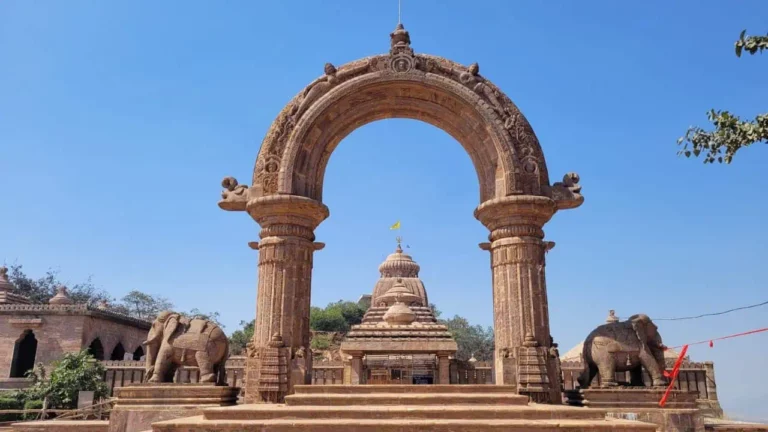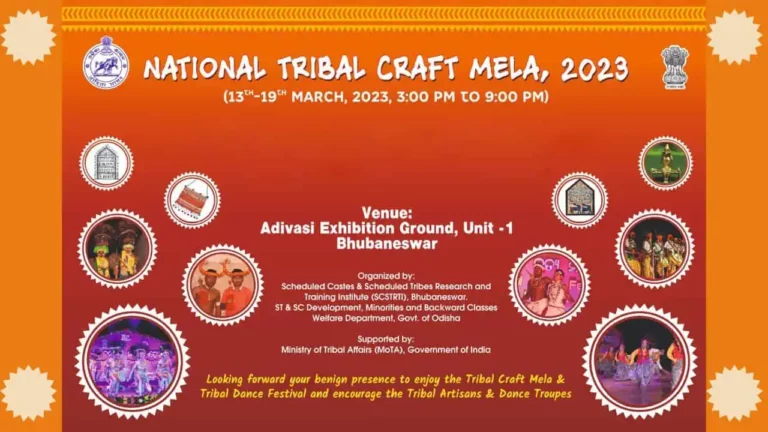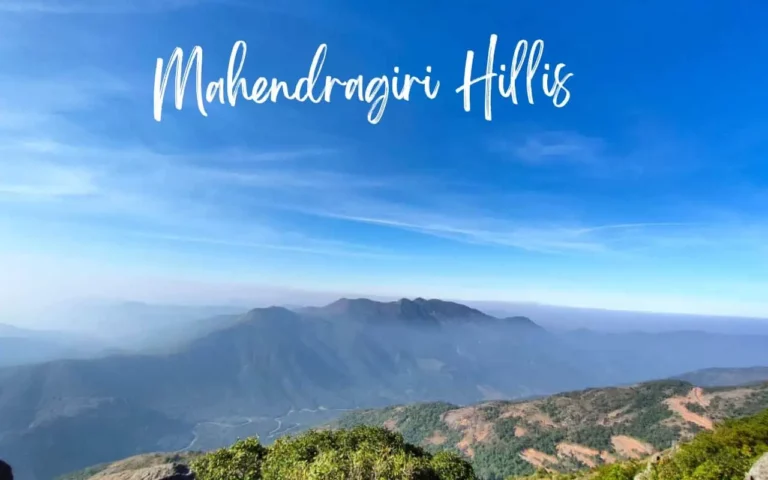Best Places to Visit in Jharsuguda District: Waterfalls, Hills, Caves, and Temples
Jharsuguda is a district in the western part of Odisha known for its rich mineral resources, industrial development, and cultural heritage. It is also home to some of the most scenic and adventurous tourist attractions in the state.
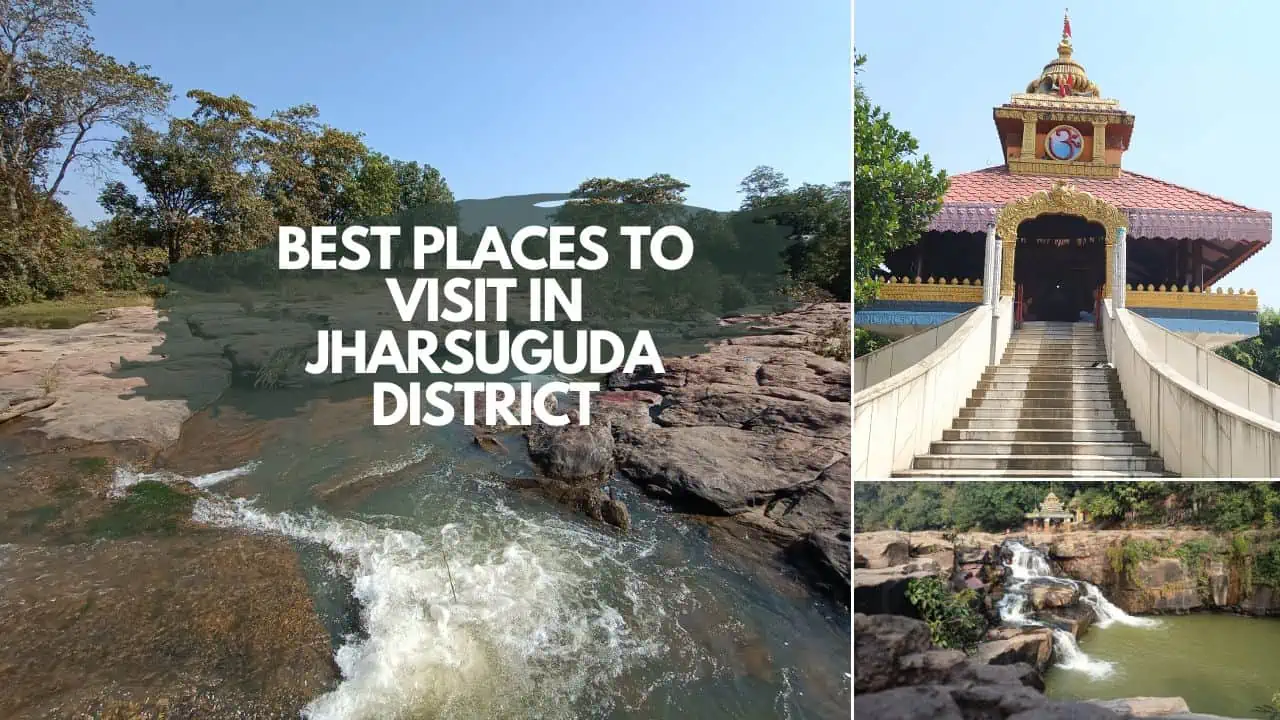
Whether you are looking for natural beauty, historical significance, or religious devotion, Jharsuguda has something for everyone.
Consider reading: Best Places to Visit in Odisha
Here are some of the best places to visit in Jharsuguda district of Odisha:
Koilighughar Waterfall
Koilighughar Waterfall is one of the most popular and picturesque waterfalls in Odisha. It is located near Lakhanpur, about 30 kilometers from Belpahar.
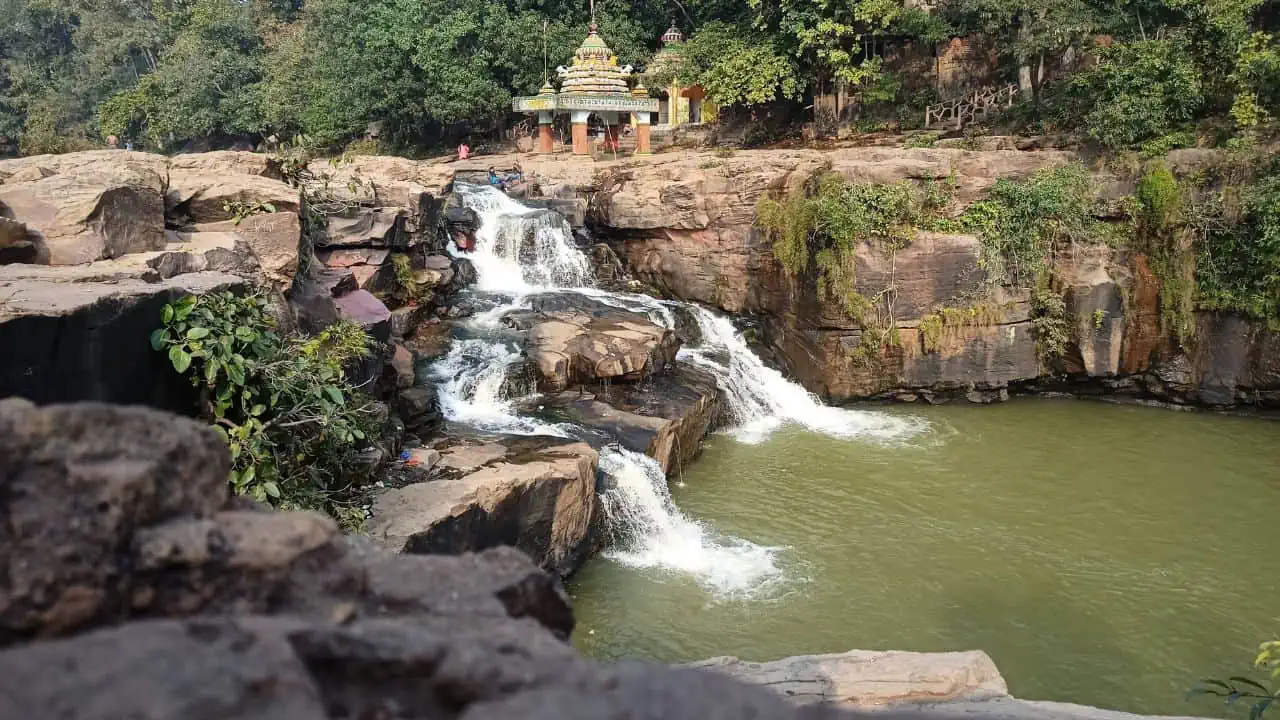
The waterfall is formed by the Mahanadi River, which plunges down from a height of about 200 feet into a deep gorge.
The sound of the roaring water and the sight of the misty spray create a mesmerizing effect. The waterfall is surrounded by lush green forests and hills, which add to its beauty and charm.
The waterfall also has religious significance, as there is an ancient Shiva temple near its base. The temple is carved out of a rock and has a natural spring inside it.
The devotees believe that the water from the spring is holy and has healing powers. The temple is also known as Koilighughar, which means ‘the cave of the bells’.
This is because there are hundreds of bells hanging from the ceiling of the cave, which are offered by the pilgrims as a mark of their faith.
How to Reach Koilighughar Waterfall
To reach the waterfall, you can take a bus or a taxi from Belpahar or Jharsuguda. You can also hire a bike or a car and drive along the scenic road that leads to the waterfall.
The road passes through several villages and fields, giving you a glimpse of the rural life of Odisha. Once you reach the waterfall, you can enjoy its beauty from various viewpoints.
You can also take a dip in the pool below the waterfall or feed the fish that live there. However, fishing is strictly prohibited, as it is considered sacred by the locals.
Best Time to Visit Koilighughar Waterfall
The best time to visit the waterfall is during the winter season when the weather is pleasant and the water level is moderate.
During the monsoon season, the waterfall becomes more voluminous and spectacular, but also more dangerous and inaccessible.
You should avoid visiting the waterfall during this time, as there are chances of landslides and flash floods.
Koilighughar Waterfall is one of the Best Places to Visit in Jharsuguda District.
Ramchandi Temple
Ramchandi temple is one of the oldest and most revered temples in Jharsuguda district. It is dedicated to Goddess Ramchandi, who is believed to be an incarnation of Goddess Durga.
The Ramchandi temple is situated on a hilltop near Brajrajnagar, about 20 km from Jharsuguda town. The temple offers a panoramic view of the surrounding landscape, which includes forests, hills, rivers, and lakes.
The garbhagriha houses the idol of Goddess Ramchandi, which is made of black stone and adorned with gold and silver ornaments. The idol has eight arms and holds various weapons and symbols in her hands. She is seated on a lion, which symbolizes her power and courage.
The Ramchandi temple attracts thousands of devotees throughout the year, especially during festivals like Durga Puja, Navratri, Rama Navami, and Basanti Puja. During these occasions, the temple is decorated with flowers, lights, and flags.
The devotees offer prayers, perform rituals, sing hymns, and dance in front of the goddess. They also participate in various cultural programs and fairs that are organized near the temple.
To reach the Ramchandi temple, you can take a bus or a taxi from Jharsuguda or Brajrajnagar. You can also hire a bike or a car and drive up to the hilltop. The road to the temple is steep and narrow, so you should be careful while driving. Alternatively, you can trek up to the temple from the base of the hill, which takes about 30 minutes.
Jhadeswar Temple
Jhadeswar temple is another ancient and sacred temple in Jharsuguda district. It is dedicated to Lord Shiva, who is worshipped as Jhadeswar or ‘the lord of Jhar’. Jhar means ‘water’ in Odia language, and it refers to the Ib river that flows near the temple.

The Jhadeswar temple is located on the banks of the river, about 3 km from Jharsuguda town. The temple is surrounded by a beautiful garden, which has a variety of flowers and plants.
The front door leads to the vimana, where the idol of Lord Shiva is installed. The idol is made of white marble and has four arms. He holds a trident, a drum, a rosary, and a snake in his hands. He is seated on a bull, which is his vehicle.
The temple is visited by devotees throughout the year, but especially during festivals like Shivaratri, Shravan Somvar, Kartik Purnima, and Makar Sankranti. During these occasions, the temple is illuminated with lamps and candles.
To Jhadeswar reach the temple, you can take a bus or a taxi from Jharsuguda town. You can also hire a bike or a car and drive along the river road that leads to the temple. The road is smooth and scenic, as it passes through green fields and villages.
Pahadi Mandir
Pahadi Mandir is a hilltop temple that offers a spectacular view of Jharsuguda town and its surroundings. It is dedicated to Lord Rama, who is believed to have visited this place during his exile.
The Pahadi temple is situated on a hill called Pahadi Hill, which is about 5 km from Jharsuguda town. The temple is also known as Ram Mandir or Ram Dham.
The temple attracts visitors throughout the year, but especially during festivals like Ram Navami, Dussehra, Diwali, and Hanuman Jayanti. During these occasions, the temple is adorned with flowers, lights, and flags.
The visitors offer prayers, perform rituals, sing bhajans (devotional songs), and listen to Ramayana (the epic story of Lord Rama). They also enjoy the panoramic view of the town from the hilltop.
To reach the Pahadi temple, you can take a bus or a taxi from Jharsuguda town. You can also hire a bike or a car and drive up to the hilltop. The road to the temple is steep and curvy, so you should be careful while driving. Alternatively, you can trek up to the temple from the base of the hill, which takes about an hour.
Pahadi Mandir is one of the Best Places to Visit in Jharsuguda District.
Pikolgughar Stream
Pikolgughar Stream is a natural attraction that offers a refreshing and relaxing experience to visitors. It is located near Kolabira village, about 25 km from Jharsuguda town.
The stream originates from a spring in the forest and flows through rocky terrain before joining the Ib River. The stream forms several pools and cascades along its course, creating a soothing sound and sight.
The stream is ideal for picnicking, swimming, fishing, boating, and camping. The visitors can enjoy the cool water of the stream or sit on the rocks and admire its beauty.
They can also explore the forest around the stream or visit the nearby Kolabira fort, which is an ancient fort built by King Ganga Vanshi during the 12th century AD.
To reach the Pikolgughar stream, you can take a bus or a taxi from Jharsuguda town to Kolabira village. You can also hire a bike or a car and drive along the road that leads to the stream. The road passes through several fields and hills, giving you a scenic view of the countryside.
Ulapgarh Hill Forts
Ulapgarh hill forts are historical attractions that offer a glimpse of the past glory and culture of Odisha. They are located on Ulapgarh Hill, which is about 15 km from Jharsuguda town. The hill has three forts, which were built by different rulers during different periods. The forts are:
- Ulapgarh Fort: This is the oldest and the largest fort on the hill. It was built by King Ganga Vanshi during the 12th century AD. The fort has a rectangular shape and covers an area of about 25 acres. The fort has four gates, one on each side, and several bastions, watchtowers, and cannons. The fort also has a temple dedicated to Lord Shiva, which is known as Ulapgarh Mahadev temple.
- Sarangarh Fort: This is the second oldest and the second largest fort on the hill. It was built by King Sarangadhar Singh Deo during the 16th century AD. The fort has a circular shape and covers an area of about 15 acres. The fort has two gates, one on the east and one on the west, and several bastions, watchtowers, and cannons. The fort also has a temple dedicated to Goddess Durga, which is known as Sarangarh Durga temple.
- Chandiagarh Fort: This is the newest and the smallest fort on the hill. It was built by King Chandi Singh Deo during the 18th century AD. The fort has a triangular shape and covers an area of about 5 acres. The fort has one gate on the south and several bastions, watchtowers, and cannons. The fort also has a temple dedicated to Goddess Chandi, which is known as Chandiagarh Chandi temple.
The forts are visited by tourists throughout the year, but especially during festivals like Durga Puja, Shivaratri, and Chaitra Purnima. During these occasions, the forts are decorated with flowers, lights, and flags.
The tourists offer prayers, perform rituals, sing songs, and dance in front of the goddesses. They also enjoy the panoramic view of the hill and the surrounding landscape.
To reach the Ulapgarh Hill forts, you can take a bus or a taxi from Jharsuguda town to Ulapgarh village. You can also hire a bike or a car and drive up to the hilltop. The road to the forts is rough and rocky, so you should be careful while driving.
Alternatively, you can trek up to the forts from the base of the hill, which takes about two hours.
Ulapgarh Hill Forts is one of the Best Places to Visit in Jharsuguda District.
Vikramkhol Cave
Vikramkhol Cave is an archaeological attraction that offers a fascinating insight into the ancient history and culture of Odisha. It is located near Belpahar town, about 40 km from Jharsuguda town.
The Vikramkhol cave is a natural rock shelter that has several paintings and inscriptions on its walls. The paintings and inscriptions date back to prehistoric times and depict various animals, humans, symbols, and scripts.
The Vikramkhol cave was discovered by British archaeologist J.P. Vogel in 1925. He named it Vikramkhol after King Vikramaditya, who was believed to have ruled over this region during the 1st century BC.
He also deciphered some of the inscriptions on the walls, which were written in Brahmi script and Prakrit language. He found out that the inscriptions were records of donations made by local rulers and merchants to Buddhist monks who lived in the cave.
To reach the Vikramkhol cave, you can take a bus or a taxi from Belpahar or Jharsuguda town to Vikramkhol village. You can also hire a bike or a car and drive along the road that leads to the cave. The road passes through several forests and hills, giving you a scenic view of the countryside.
Rampaluga Picnic Spot
Rampaluga picnic spot is a recreational attraction that offers a fun-filled experience to visitors. It is located near Rampaluga village, about 20 km from Jharsuguda town.
The Rampaluga picnic spot is situated on the banks of Ib River, which forms a large lake near the village. The lake is surrounded by green fields and hills, which create a serene atmosphere.
The picnic spot also has a children’s park, which has various swings, slides, and rides for the kids. The park also has a small zoo, which has some animals and birds like deer, monkeys, peacocks, and parrots. The kids can have fun playing in the park or watching the animals and birds.
The picnic spot is visited by families, friends, and couples throughout the year, but especially during weekends and holidays. During these times, the picnic spot is crowded with people who come to enjoy nature and the activities.
The picnic spot also hosts various cultural events and competitions, which add to the excitement and entertainment.
To reach the Rampaluga picnic spot, you can take a bus or a taxi from Jharsuguda town to Rampaluga village. You can also hire a bike or a car and drive along the road that leads to the picnic spot. The road is smooth and scenic, as it passes through green fields and hills.
Lal Patthar Belpahar
Lal Patthar Belpahar is a geological attraction that offers a unique and amazing experience to visitors. It is located near Belpahar town, about 35 km from Jharsuguda town.
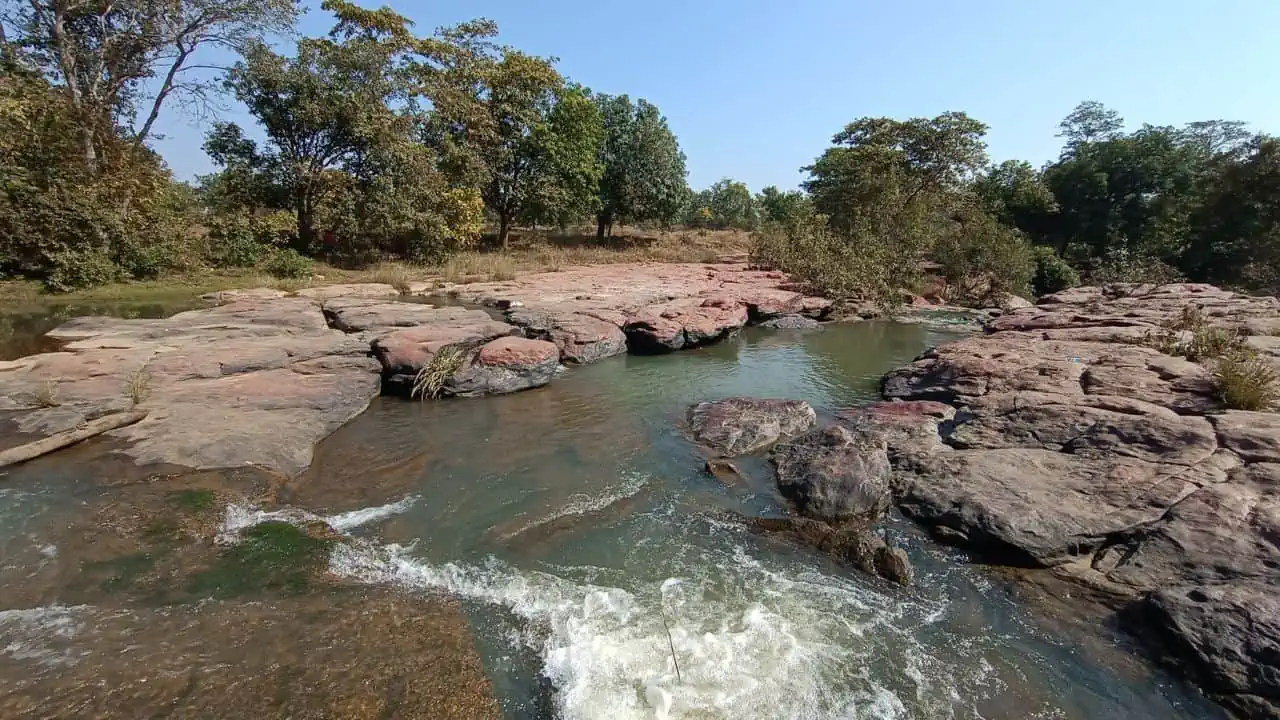
Lal Patthar Belpahar means ‘red stone hill’, which refers to the hill that is made of red sandstone. The hill has various shapes and formations of rocks, which look like sculptures carved by nature.
The hill is a result of erosion and weathering of the sandstone over millions of years. The hill has different layers of colors, which range from red to yellow to white. The hill also has various caves, crevices, and holes, which add to its mystery and charm.
The hill is ideal for hiking, rock climbing, photography, and exploration. The visitors can climb up the hill or walk around it and admire its beauty and diversity. They can also enter some of the caves or holes and discover their secrets. They can also take pictures of the hill or pose with its rocks.
The hill is visited by adventure seekers, nature lovers, and photographers throughout the year, but especially during sunrise and sunset. During these times, the hill glows with different shades of colors, creating a stunning spectacle.
The hill also offers a splendid view of the surrounding landscape, which includes forests, fields, rivers, and lakes.
To reach Lal Patthar Belpahar, you can take a bus or a taxi from Belpahar or Jharsuguda town to Lal Patthar village. You can also hire a bike or a car and drive along the road that leads to the hill. The road is rough and dusty, so you should be careful while driving.
Bhalu Dumri
Bhalu Dumri is an ecological attraction that offers a refreshing and relaxing experience to visitors. It is located near Maheswari village, about 45 km from Jharsuguda town.
Bhalu Dumri means ‘bear’s den’, which refers to the cave that is inhabited by bears. The cave is situated on a hilltop near Maheswari forest reserve.
The cave is a natural rock shelter that has several chambers and passages inside it. The cave is home to several bears, who live there peacefully and harmoniously.
The bears are friendly and harmless to humans unless provoked or disturbed. The cave also has some paintings and inscriptions on its walls, which are believed to be made by ancient tribes who lived in this region.
The cave is visited by wildlife enthusiasts, researchers, students, and tourists throughout the year, but especially during the winter season.
During this time, the bears hibernate in the cave and can be seen sleeping or resting in their chambers. The visitors can observe them from a safe distance or take pictures of them with permission from the forest officials.
To reach the Bhalu Dumri cave, you can take a bus or a taxi from Jharsuguda town to Maheswari village. You can also hire a bike or a car and drive along the road that leads to the cave.
The road passes through the Maheswari forest reserve, which has various flora and fauna. You need to obtain permission from the forest department before entering the reserve or visiting the cave.
Hatianala & Barjha Dam
Hatianala & Barjha Dam are engineering attractions that offer a splendid view of Jharsuguda district’s water resources.
Hatianala & Barjha Dam are located near Hatianala village, about 10 km from Jharsuguda town. The dams are built on the Ib River, which is the main source of water for irrigation, drinking, and industrial purposes in the Jharsuguda district.
The dams are also used for generating hydroelectric power, which supplies electricity to the nearby towns and villages.
The dams are impressive structures that showcase the engineering skills and achievements of Odisha. The dams have several gates, turbines, generators, and control rooms, which regulate the flow and level of water in the river.
The dams also have several bridges, walkways, and observation decks, which allow the visitors to view the dams and the river from different angles.
The dams also create a large reservoir behind them, which forms a beautiful lake. The lake is ideal for boating, fishing, and birdwatching.
To reach the Hatianala & Barjha dams, you can take a bus or a taxi from Jharsuguda town to Hatianala village. You can also hire a bike or a car and drive along the road that leads to the dams. The road is smooth and scenic, as it passes through green fields and hills.
Closing Thoughts on Best Places to Visit in Jharsuguda District
These are some of the best places to visit in Jharsuguda district of Odisha. I hope you enjoyed reading this article and found it informative and helpful.
You can explore the waterfalls, temples, forts, caves, hills, lakes, dams, and stone art of Jharsuguda and experience its rich culture and heritage.
You can also interact with the local people and learn about their lifestyle and traditions. Jharsuguda is a place that will leave you with unforgettable memories and impressions.
Thank you for your time and attention. I hope you found this article useful and interesting.
If you have any questions or feedback, please feel free to contact me. I would love to hear from you. Have a great day and happy traveling!
